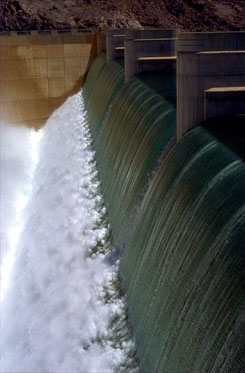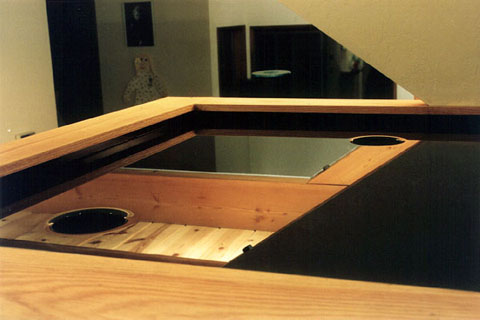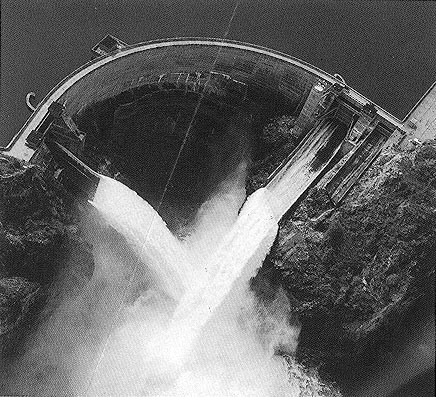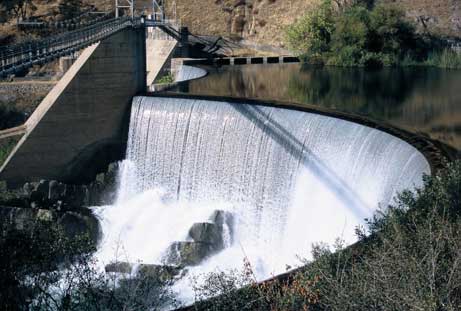

With the exception of Boundary Dam and Mondrian Hotel, images were taken by and are copyright © Eric A. Hulteen 2001-2022.
Edited on Thursday 14 April 2022.
 Words are not my medium of expression. I'm trying here to represent the history of my relatioinship with water and what's important to me about water, but writing about water is not what I do.
Words are not my medium of expression. I'm trying here to represent the history of my relatioinship with water and what's important to me about water, but writing about water is not what I do.
Water is an enthusiasm for me. One Friday in 1983 while I was at work I heard that the Colorado River was flooding and, in particular, that water was flowing over the spillways at Hoover Dam. Since the dam had been built there had never been a flood at Hoover that required the use of the spillways (although they'd been tested by intentional flooding after the dam was completed). After work that Friday afternoon I went home, packed a change of clothes and a camera, and left for Hoover Dam. I drove all night, stopping at 4:00 AM for a few hours sleep while waiting for the sun to come up. The sun rose, I was at the dam, I shot roll after roll, got back in the car, and drove home, 575 miles each way.
My interest in water began at a young age, maybe because I lived near a pond. I once enlisted the help of all the other children in my neighborhood to build a dam across a nearby creek. When completed it flooded the back yards of three houses and required the town's Department of Public Works to bring in a crane to dismantle it.
In some sense water is the most interesting thing in the world and the most interesting kind of water is water in motion. It moves as though it were alive and I see and feel poetry in the motion. I especially like water flowing through and around human constructions such as fountains and dams, and that's most of what you'll find in the other sections of this page.
 I design and build water fountains. The one shown here is a pool of water in a stairwell. It reflects the walls and ceilings around it. The pool is about three feet by four and is made of a black material so that what contains the water is, so far as possible, invisible. What you see are the reflections. Interrupting the reflections are two four-inch diameter holes. They're black -- reflecting nothing. They "float" in the reflections while the water flows down into them to disappear.
I design and build water fountains. The one shown here is a pool of water in a stairwell. It reflects the walls and ceilings around it. The pool is about three feet by four and is made of a black material so that what contains the water is, so far as possible, invisible. What you see are the reflections. Interrupting the reflections are two four-inch diameter holes. They're black -- reflecting nothing. They "float" in the reflections while the water flows down into them to disappear.
 For vacations I often take a long drive (1,000 to 2,000 miles) and stop at dams and bridges along the way. One of my favorite dams is the Boundary Dam in the state of Washington.
For vacations I often take a long drive (1,000 to 2,000 miles) and stop at dams and bridges along the way. One of my favorite dams is the Boundary Dam in the state of Washington.
The Boundary Dam was completed in 1967 and provides hydroelectric power for the city of Seattle, Washington. It sits on the Pend Oreille River, a tributary of the Columbia River, about one mile from the Canadian border in the far northeast corner of Washington state. The dam is a variable-radius, thin concrete arch 340 feet high, 32 feet thick at the base, and 8 feet thick at the crest. In addition to three spillway gates at the crest of the dam there are seven sluiceways (i.e., doors) built into the body of the dam 200 feet below the crest. Each of these sluiceways is 17 feet wide and 21 feet high. Their purpose is to protect mines located upstream of the dam. If water from the reservoir were to flood the mines the seven sluiceways would be opened causing the reservoir water level to be lowered by 175 feet within 8 hours. The dam's power station is completely invisible; housed in an underground hall 76 feet wide, 170 feet high, and 477 feet long carved out of solid rock in the left abutment (canyon wall). There are six turbine-generators with an electrical energy production capacity of 1,000 MW.
To see more pictures of this dam from my second visit to it see the web page of my recent trip to the Northwest.
 I originally saw this dam in the summer of 1995, but neglected to write down its name or location. I took three trips to the Sierra Nevada in subsequent years looking for it. Finally, in October of 2001 I found it again by looking for it where my brother remembered it to be rather than where I remembered it to be.
I originally saw this dam in the summer of 1995, but neglected to write down its name or location. I took three trips to the Sierra Nevada in subsequent years looking for it. Finally, in October of 2001 I found it again by looking for it where my brother remembered it to be rather than where I remembered it to be.
Technically, I believe that it's a weir (rather than a dam) because it's used to control the height of the river and the water flows over it uncontrolled.
I've posted all twelve pictures I took on my October, 2001 trip to the dam.
 What I like about this pool is that the water level is controlled by letting the water wash over the edges of the pool and then into drains (shown as the thin black co-linear lines around the outside edge). In effect, there are no sides; the water just flows over the edges at will.
What I like about this pool is that the water level is controlled by letting the water wash over the edges of the pool and then into drains (shown as the thin black co-linear lines around the outside edge). In effect, there are no sides; the water just flows over the edges at will.